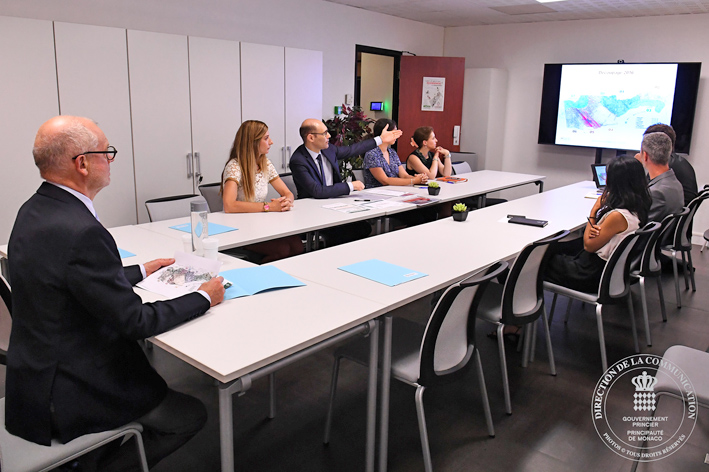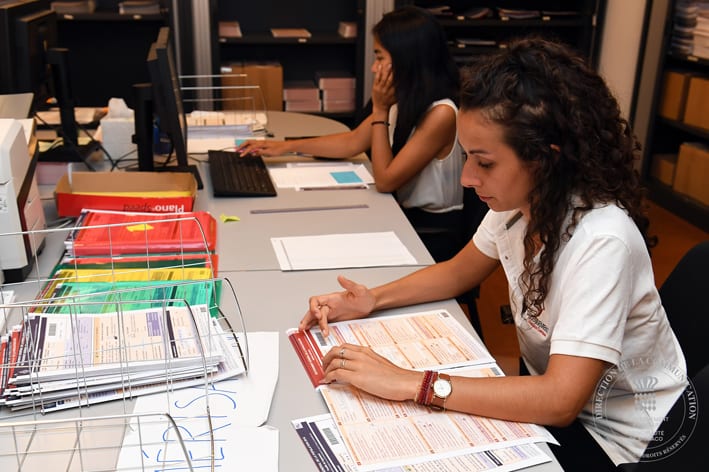
At this year’s Cannes Film Festival, I attended the Marché Du Film’s “Refugee Voices in Film”, a collaboration between the Monaco-based International Emerging Film Talent Association (IEFTA) and the United Nations High Commissioner for Refugees (UNHCR).
The keynote address from Vincent Cochetel, UNHCR’s Director for the Bureau of Europe, set the tone: “Europe is trying to understand what happened last year. It’s like a hangover. You wake up and there are one million displaced people.”
But Mr Cochetel underlined the need to understand that a million migrants means a million unique people, each with a story.
This sentiment is shared by Mr Lionel Galfré, Director of IMSEE, the Institut Monégasque de la Statistique et des Études Economiques, which was set up in 2011. “Each person is a statistic,” he tells me, “and so behind every number there is a man, woman or child.”
I meet with Mr Galfré at IMSEE’s office, near Décathlon in Fontvieille, to discus the recent census and find out how this Economics major ended up working at Monaco’s institution for statistics.
Although Mr Galfré’s mother is Monegasque, the 43-year-old lived most of his life outside Monaco, in France and in Italy, working in international trade for the plastics industry. He was a branch director at Groupe Berchet in Milan for three years before moving over to their international operations in Oyonnax (Ain) as director, also for three years. He then ended up working briefly for in Paris for a Franco-Japanese and Chinese company before returning to Monaco. “Then I came back to the Principality to work in the directorate of economic expansion but moved on fairly quickly to statistics, which I’ve always been particularly interested in.”
Mr Galfré joined IMSEE at its inception in 2011. “I completely agree with IMSEE’s motto: ‘you need to measure to understand’. We measure, look at trends and try, if possible, to understand.”
The institute
The Monaco Institute of Statistics and Economic Studies was created only five years ago and has eight people in the department, most of them with a background in statistics or economic studies, and there’s also a legal expert.
Before IMSEE, the division responsible for statistics and economic studies was part of the directorate of economic expansion, which fell within the Directorate of Finance and Economy. “It was a small department that conducted small-scale studies with fewer resources and less legitimacy than IMSEE,” Mr Galfré explains from his office. “Today, our service responds to the Minister of State.”
I ask the Director about a typical day at the statistics office. “We try to be very open and available to the outside world, and have some contact with the general public, say for company registration, but it’s not our major role. Our main activity is collecting and analysing data and writing reports.”
IMSEE focuses firstly on Monegasques entrepreneurs, investors and so forth because “they are the ones experiencing the day-to-day life that we try to measure, and we need to maintain a close link with their reality so that we can correctly interpret the figures”. And secondly, to other Monegasque administrations as their services also gather vital information.
The gathering of data at IMSEE falls into two core sectors – Economy & Finance and
Population & Employment – and IMSEE studies are published without being “filtered” by the state.

The data
One of the institute’s regularly published reports is the quarterly Economic Bulletin. It pulls data from difference services within the Monegasque administration, from fiscal services concerning turnover, to the social organisation on employment, to the treasury directorate for credit and bank deposit information.
“These reports help us to understand how the Monegasque economy is doing and explain the main trends in terms of employment, turnover and tourism. This makes the economic situation clearer to people making investment or financial management decisions, Mr Galfré points out.
IMSEE also publishes a monthly retailing barometer based on data collected from retailers about their sales, inventory, payments and number of customers. This “takes the temperature” of the retail sector and provides insight to retail chains with points of sale in different countries to compare the dynamic in Monaco with that in a wider economic context.
“Putting the statistics in context is important,” Mr Galfré insists. Take the cruise industry in Monaco as an example. “We know that the number of cruise passengers in Monaco has been dropping over the past two years. This is the direct result of a change in policy from the Monegasque Office of Tourism and Congress to attract smaller cruise liners, which obviously accommodate fewer passengers, but at a higher level of luxury and price. So we are able to explain the reduction in the number of cruise passengers in the light of this change in strategy.”
Mr Galfré adds that given the economic context around the world, “we can show that Monaco is also following a trend but generally coping better than, for example, the French Riviera”.
Another frequent publication is the Focus Report, which comes out around 15 times a year and spotlights a particular topic like weather or sex equality, or sectors such as retail, industry and education.
“We also have observatories that provide more in-depth data in a particular area, say retail observatory, industry observatory or demographics observatory, to allow us to study the Monegasque population in detail according to international indicators, such as life expectancy, birth rate and so forth. These are published once a year.”
Some of IMSEE’s studies are published in English online (imsee.mc). “Monaco in Figures”, a compilation of all the statistics about the Principality, can be found online and the print version is available for purchase.
Stating that IMSEE is both lucky and unlucky to be a young institute, with a young team, Mr Galfré describes that group as “still enthusiastic and dynamic” with a lot of plans in mind.
One such project is to strengthen its partnerships with foreign entities such as international polling agencies or foreign statistic organisations, which would allow the institute to open up its statistics outside Monaco. “For example, we conduct a European study, under international guidelines, every four years on alcohol, cigarette and illicit drug use by high school students.”

The census
A census has been carried out in Monaco, according to Mr Galfré, since 1783, occurring every eight to ten years. The current campaign was launched June 9 and finished July 29. “We’re cleaning up the data now and results will be ready the first quarter of 2017.”
I look outside of Mr Galfré’s office and see two young women sitting at a table, sorting through paper copies of the survey, one by one, as the director goes through the process.
Four members of IMSEE work on the census, one is responsible for communication and is in contact with the different Monegasque communities, including the Anglophone community. “IMSEE uses different local French and non-French media, including radio and TV, plus visual publicity campaigns. “Our message is that participating in the census is a civic duty and in everyone’s best interest.”
Everyone living in Monaco, whether they are resident or not, receives in their letter box two questionnaires, one about the characteristics of their home and the other, an individual questionnaire for each member of the household.
Fifty specially recruited census agents (and dressed to be easily recognisable to avoid others posing as censor agents) go door-to-door delivering the census documents and are supervised by eight public service officials. The inhabitants fill in the information about their situation – if they are employed, their family situation, if they are a full-time resident in Monaco, their nationality, if the address is their main or secondary residence, their level of education and so on. The second questionnaire is about their housing,
The two main objectives of the census are to count and characterise the number of apartments and to count and characterise the number of inhabitants. “The information will tell us how many housing units there are in Monaco, and their level of development – size, level of comfort, equipped with double glazing, parking facilities – which helps public authorities to implement public policies, and helps IMSEE to know more about the population residing in Monaco, the typology of the population and the demographics. In turn, this provides politicians and government with the tools to forecast facilities such as nurseries, schools, health care centres, and retirement homes.”
The census also gives information about how the population gets around in Monaco, on foot, bike, bus or car, to help in the government in the management of transport infrastructure.

The census is not digital, although the results are scanned and entered into a database, but anonymously. Mr Galfré emphasises, “The purpose of a census is to collect an individual’s data only to guide public policy, so the personal data is anonymous and confidential. We’re not interested in the name of a particular person. The census does not ask about salaries earned or about religion. We’ve learned from Russian residents that in their country, for example, the census is completely different. In the UK, it’s different again.”
The significance
Figures are not abstract – they always represent something. So while the popular image of statisticians is rather austere, Mr Galfré insists they must be rigorous because behind each figure is a reality. “If we look at the annual demographic study, life expectancy is something concrete. It says something about people’s living conditions. If we take the Economic bulletin, are trends moving up or down? On a European level today we know that the trend for employment is not very optimistic, so where is Monaco positioned in that context? Monaco is creating jobs at a rate of around 2% per year but how long will this last?”
There was a small dip in employment in the last quarter of 2015, but the first quarter of 2016 it took off again. This can be taken as an indication that Monaco’s business can create activity and resist in a disruptive economic environment.
“If we look at the growth rate, the GDP, which expresses the economic health of a country, is 4%. If there is growth, it means that the country’s economy is expanding more than in the previous year. In Monaco, the growth rate tends to be positive.”
Mr Galfré is passionate in saying there’s a reality behind each figure and with the data from the census we can understand people’s lifestyles. “Being able to measure and count has allowed us to highlight certain phenomena and therefore improve the lives of individuals. We can’t react unless we first measure.”
For Lionel Galfré, behind every statistic is a story worth telling.
Sign up for IMSEE’s free newsletter at imsee.mc
Article first published October 6, 2016.
